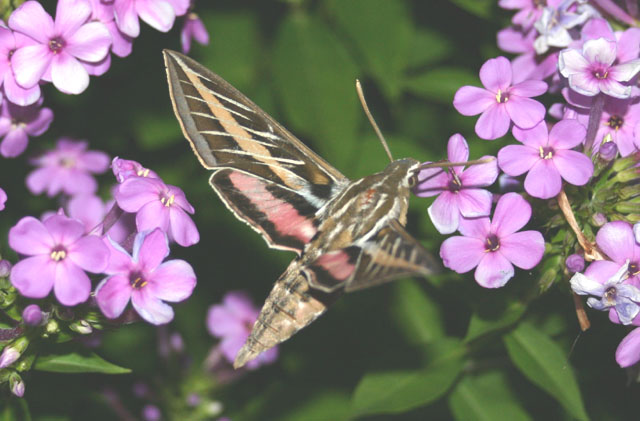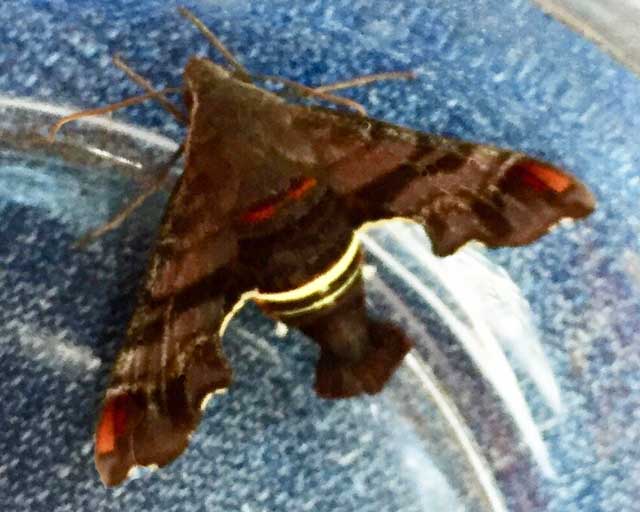Ramsey County, Minnesota, and Nearby Counties:
Anoka; Sherburne; Isanti; Scott
Sphingidae
|
|
Updated as per James P. Tuttle's The Hawk Moths of North America, July 6, 2010 Updated as per personal communication with Duane McDowell, August, 2005 Updated as per personal communication with Emily and Iris Mirski (Deidamia inscriptum); July 6, 2010 Updated as per personal communication with Emily Mirski (Amphion floridensis, May 2010); July 8, 2010 Updated as per personal communication with Jesse Kroese (Amphion floridensis, St. Paul, June 24, 2019); June 26, 2019 Updated as per BAMONA, June 26, 2019 |

A "WO" after the species name indicates that I have no confirmed reports of this species in your county, but I (William Oehlke) expect that this moth is present or might be present. I have included many species not on the USGS list for Minnesota; I believe they are or might be present
A "USGS" indicates the moth is reported in Lepidoptera of North America, #1. Distribution of Silkmoths (Saturniidae) and Hawkmoths (Sphingidae) of Eastern North America, an excellent little booklet available through Paul Opler.
Please help me develop this list with improved, documented accuracy by sending sightings (species, date, location), preferably with an electronic image, via email to Bill Oehlke. Please also send your sightings tyo BAMONA
Many thanks to Jesse Kroese who provides the following image from St. Paul, June 24, 2019.

Amphion floridensis, St. Paul, Ramsey County, Minnesota,
June 24, 2019, courtesy of Jesse Kroese. slight digital repair by Bill Oehlke.
Although this page was originally created as a reference for Ramsey County, it also serves as a valid checklist for neighbouring counties of
Anoka: Ceratomia undulosa; Sphinx drupiferarum; Pachysphinx modesta; Paonias excaecata; Paonias myops; Eumorpha achemon; Eumorpha pandorus; Hyles euphorbiae; Hyles lineata;
Sherburne: Pachysphinx occidentalis; Smerinthus cerisyi; Hemaris thysbe; Eumorpha achemon; Eumorpha pandorus;
Isanti: Manduca quinquemaculatus; Sphinx drupiferarum;
Scott: Ceratomia amyntor; Paonias excaecata; Hemaris thysbe; Amphion floridensis; Hyles euphorbiae.
Visit Ramsey County Sphingidae Larvae.
Visit Minnesota Catocala: Underwing Moths.
Visit similar checklists at Sphingidae of the Americas where there are checklists for every state in US, every province in Canada;
Mexico, all countries in Central and South America.
Sphinginae subfamily
Smerinthini Tribe:
Macroglossinae subfamilyDilophonotini tribe:
See Hemaris comparisons.
Philampelini tribe:
Macroglossini tribe:
Amphion floridensis nectaring at lilacs, Arden Hills, June 14-19, 2008, Valerie Sweidan. Amphion floridensis, Saint Paul, May 2010, Emily Mirski. Amphion floridensis, St. Paul, June 24, 2019, Jesse Kroese
|
Enjoy some of nature's wonderments, giant silk moth cocoons. These cocoons are for sale winter and fall. Beautiful Saturniidae moths will emerge the following spring and summer. Read Actias luna rearing article. Additional online help available.
Eggs of many North American species are offered during the spring and summer. Occasionally summer Actias luna and summer Antheraea polyphemus cocoons are available. Shipping to US destinations is done from with in the US.
Use your browser "Back" button to return to the previous page.
This page is brought to you by Bill Oehlke and the WLSS. Pages are on space rented from Bizland. If you would like to become a "Patron of the Sphingidae Site", contact Bill.
Please send sightings/images to Bill. I will do my best to respond to requests for identification help.
 Show appreciation for this site by clicking on flashing butterfly to the left. The link will take you to a page with links to many insect sites. |